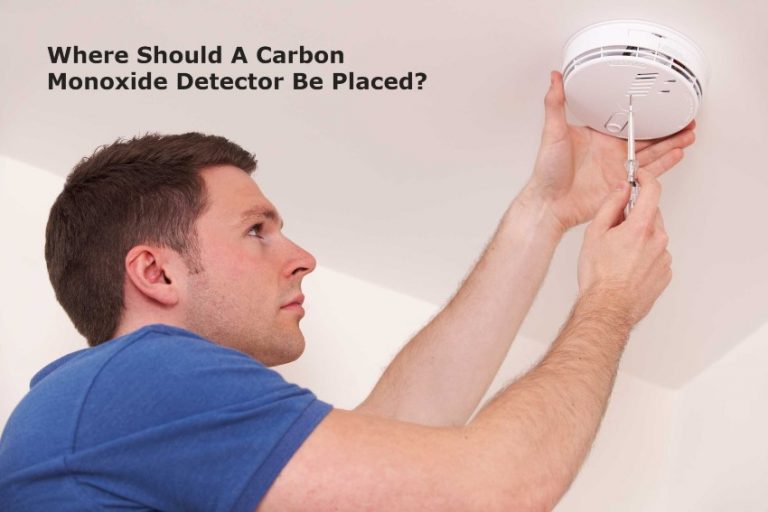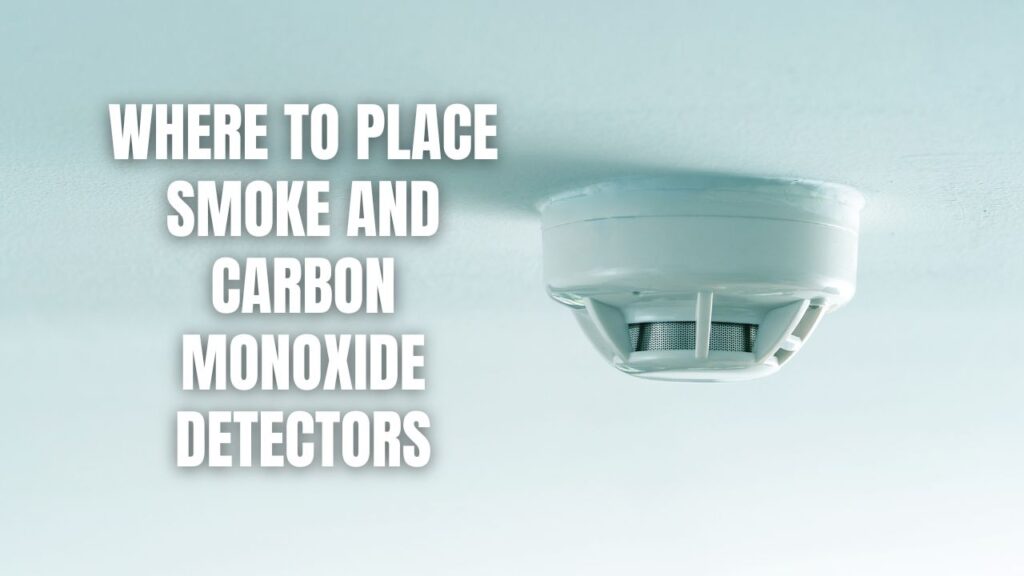Where Do I Put Carbon Monoxide Detectors

Carbon monoxide (CO) is an odorless, colorless gas that can be deadly. Because it's undetectable without specialized equipment, carbon monoxide detectors are essential safety devices for homes, apartments, and commercial buildings. However, simply having a detector isn't enough; proper placement is crucial for ensuring they can effectively alert occupants to dangerous CO levels. This guide provides detailed recommendations for optimal CO detector placement, considering various building types and HVAC systems.
Understanding CO Sources and Detector Function
CO is produced by the incomplete combustion of fuels such as natural gas, propane, oil, kerosene, wood, and charcoal. Common sources in residential and commercial settings include:
- Furnaces: Gas or oil-fired furnaces are a primary source, especially if they are poorly maintained or have a cracked heat exchanger. A cracked heat exchanger allows exhaust gases, including CO, to leak into the air circulating through the building.
- Water Heaters: Similar to furnaces, gas-powered water heaters can produce CO if not properly ventilated or maintained.
- Fireplaces: Wood-burning fireplaces can release CO into the home, particularly if the chimney is blocked or the damper is closed prematurely.
- Appliances: Gas stoves, ovens, and clothes dryers can also generate CO, though typically in smaller amounts than heating appliances.
- Generators: Portable generators are a significant CO hazard and should never be operated indoors or in enclosed spaces, even with ventilation.
- Vehicles: Running a car or other vehicle in an attached garage, even for a short time, can quickly raise CO levels to dangerous concentrations.
CO detectors work by sensing the concentration of CO in the air. When CO levels exceed a certain threshold, the detector sounds an alarm to alert occupants. There are two main types of CO detectors:
- Biomimetic Sensors: These detectors use a gel that changes color in the presence of CO. A change in color triggers the alarm.
- Electrochemical Sensors: These detectors use electrodes in a chemical solution. When CO is present, it causes a change in electrical current, triggering the alarm. These are the more common type.
Optimal Placement Guidelines: Residential Properties
For homes and apartments, adhering to established guidelines significantly improves the effectiveness of CO detectors. Consult local building codes, as they may have specific requirements.
General Recommendations
- Install at least one CO detector on each level of the home: This ensures that occupants are alerted regardless of where the CO leak originates. This is especially important if bedrooms are located on different levels.
- Place detectors outside each sleeping area: This ensures that occupants are awakened by the alarm even when asleep.
- Position detectors on the ceiling or high on the wall: CO is slightly lighter than air and tends to rise. Placement on the ceiling or high on the wall allows the detector to detect CO more quickly. For wall placement, install the detector 4-12 inches below the ceiling.
- Keep detectors away from fuel-burning appliances: While it might seem logical to place detectors directly next to furnaces or water heaters, this can lead to false alarms. Place detectors at least 10 feet away from these appliances. Exceptions exist if specifically instructed by the detector manufacturer.
- Avoid obstructing the detector: Do not place furniture or curtains in front of the detector, as this can impede its ability to sense CO.
- Do not place detectors in damp or humid areas: Bathrooms and laundry rooms can damage the detector's sensor.
Specific Room Considerations
- Bedrooms: As mentioned, place a detector outside each sleeping area. For bedrooms on different floors, ensure each bedroom has a detector in close proximity.
- Living Rooms: A detector in the living room is recommended, especially if a fireplace or other fuel-burning appliance is present.
- Basements: Basements often house furnaces and water heaters. A detector is essential in the basement, especially near these appliances.
- Garages: If the garage is attached to the house, a detector should be placed in the hallway leading from the garage to the living area. This will help detect CO that may seep into the house from vehicles.
Example Scenario
Consider a two-story home with a basement. The furnace and water heater are located in the basement. The bedrooms are located on the second floor. In this scenario, the homeowner should install at least three CO detectors: one in the basement near the furnace and water heater (but at least 10 feet away), one on the first floor near the staircase leading to the second floor, and one on the second floor outside the bedrooms.
Optimal Placement Guidelines: Commercial Buildings
In commercial buildings, CO detector placement is governed by building codes and fire safety regulations. Consult with a qualified fire protection engineer or local authorities to ensure compliance.
General Recommendations
- Comply with local building codes: These codes typically specify the number and location of CO detectors required in commercial buildings.
- Install detectors in mechanical rooms: Mechanical rooms that house furnaces, boilers, and other fuel-burning equipment are high-risk areas.
- Place detectors in areas adjacent to mechanical rooms: This provides an early warning system in case of CO leaks.
- Install detectors in hallways and common areas: This ensures that all occupants are alerted to CO hazards.
- Consider placement in areas with potential for CO infiltration: Examples include parking garages, loading docks, and areas near exhaust vents.
- Ensure detectors are accessible for testing and maintenance: Detectors should be easily accessible for regular testing and battery replacement.
HVAC System Considerations
The placement of CO detectors should also take into account the building's HVAC system. Specifically, consider:
- Air Handling Units (AHUs): Place detectors near AHUs that draw air from areas with potential CO sources.
- Return Air Ducts: Detectors can be placed in return air ducts to detect CO before it is circulated throughout the building.
- Exhaust Fans: Detectors should be placed near exhaust fans that vent exhaust gases from fuel-burning appliances.
Example Scenario
Imagine an office building with a central heating plant located in the basement. The heating plant contains boilers that burn natural gas. In this scenario, the building manager should install CO detectors in the mechanical room housing the boilers, in the hallways on each floor of the building, and in the return air ducts of the HVAC system. The manager should also consult with a fire protection engineer to ensure compliance with local building codes.
Maintenance and Testing
Proper maintenance and regular testing are crucial for ensuring that CO detectors function correctly. Follow these guidelines:
- Test detectors monthly: Use the test button on the detector to verify that the alarm sounds.
- Replace batteries annually: Even if the detector has a long-life battery, it's a good practice to replace the batteries annually. Many people do this when they change their clocks for daylight saving time.
- Replace detectors according to manufacturer's instructions: CO detectors have a limited lifespan, typically 5-10 years. Replace detectors before their expiration date.
- Keep detectors clean: Dust and debris can interfere with the detector's sensor. Clean the detector regularly with a soft brush or vacuum cleaner attachment.
Ignoring these maintenance steps renders the detector ineffective. Consider setting reminders in your calendar to ensure regular testing and maintenance.
Cost Considerations
The cost of CO detectors varies depending on the type, features, and brand. Battery-powered detectors are typically less expensive than hardwired detectors with battery backup. Detectors with digital displays that show CO levels are generally more expensive than basic models.
For residential properties, the cost of installing CO detectors is relatively low, typically ranging from $20 to $50 per detector. The long-term benefits of preventing CO poisoning far outweigh the initial cost.
For commercial buildings, the cost of installing CO detectors can be more significant, especially for large buildings with complex HVAC systems. However, investing in CO detection is essential for protecting the health and safety of building occupants and complying with building codes.
Integrating with Smart Home Systems
Many modern CO detectors can be integrated with smart home systems. These detectors can send alerts to your smartphone or other devices if CO is detected, even when you are away from home. Some smart detectors can also be integrated with smart thermostats to automatically shut down the HVAC system in the event of a CO leak. Nest Protect is a popular example of a smart CO detector.
Professional Installation Considerations
While many homeowners can install battery-powered CO detectors themselves, hardwired detectors require professional installation by a qualified electrician or HVAC technician. Professional installation ensures that the detector is properly wired and connected to the building's electrical system. It also ensures that the detector is installed in compliance with local building codes.
For commercial buildings, professional installation of CO detectors is almost always required. A qualified fire protection engineer or HVAC technician can assess the building's CO hazards and recommend the optimal placement of detectors. They can also ensure that the detectors are integrated with the building's fire alarm system.
Conclusion
Proper placement of carbon monoxide detectors is critical for protecting the health and safety of occupants in homes and commercial buildings. By following the recommendations outlined in this guide, homeowners, property managers, and HVAC technicians can ensure that CO detectors are effectively detecting CO leaks and alerting occupants to potential hazards. Regular maintenance and testing are also essential for ensuring that detectors function correctly. Ultimately, investing in CO detection is a small price to pay for the peace of mind that comes with knowing that you and your loved ones are protected from this silent killer. Remember to always prioritize safety and consult with qualified professionals when necessary to ensure optimal CO detection in your specific environment. Never compromise on safety when it comes to carbon monoxide!










